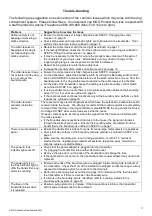
2
© MGG Products New Zealand 2021
Index
Page Number
Contents
3
Additional items you may need
3
Key-terms
3
Suitable for
4
How the system works
4
Warranty
4
Operating Guide
STEP 1: Positioning the transmitter
5
STEP 2: Laying out the system
5
STEP 3: Layout the proposed boundary-wire
7
STEP 4: Connecting the boundary-wire to the transmitter
8
STEP 5: Preparing the collar-receiver
9
STEP 6: Setting the boundary width & testing the Collar-receiver
10
STEP 7: Installing the boundary wire
11
STEP 8: Placing the boundary training flags
12
STEP 9: Fitting the collar-receiver
12
Step 10: Training Guide
13
Trouble-shooting
17
Short loop test
18
Locating a break in the wire
18
Terms of use and limitation of liability
19
Caution
19
MGG offer a return-to-base warranty for 12 months against faulty manufacture
Please retain your original invoice for warranty purposes



































